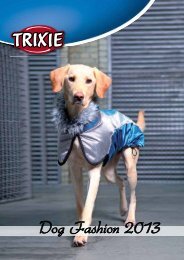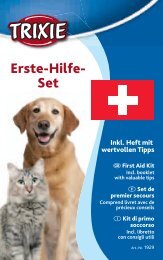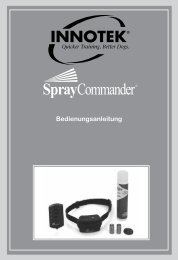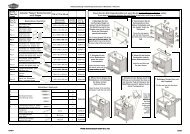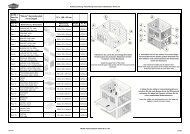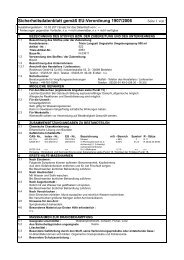Trainingsanleitung für Dog Activity Agility Wippe Art. 3213 - Trixie
Trainingsanleitung für Dog Activity Agility Wippe Art. 3213 - Trixie
Trainingsanleitung für Dog Activity Agility Wippe Art. 3213 - Trixie
Create successful ePaper yourself
Turn your PDF publications into a flip-book with our unique Google optimized e-Paper software.
<strong>Trainingsanleitung</strong><br />
Allgemeine Hinweise:<br />
1. Vor dem Sport sollte sich Ihr Hund immer aufwärmen (etwas<br />
laufen oder mit leichten Übungen beginnen).<br />
2. Nie mit vollem Magen trainieren oder gleich nach dem<br />
Training füttern. Leichte Snacks zur Belohnung sind erlaubt.<br />
3. Steigern Sie die Anforderungen an Ihren Hund nur langsam,<br />
damit er nicht überfordert wird.<br />
4. Passen Sie den Sport Ihrem Hund an und beachten Sie dabei<br />
Rasse, Alter, Talent und Größe Ihres Hundes.<br />
5. Gewähren Sie während des Trainings ausreichend Pausen,<br />
damit Ihr Hund nicht überfordert wird und die Freude erhalten<br />
bleibt. Stellen Sie immer einen Napf mit Wasser bereit und<br />
lassen Sie ihn nach dem Trinken kurz verschnaufen.<br />
6. Beachten Sie, dass das Training immer mit einer positiven<br />
Erfahrung beendet werden sollte.<br />
7. Mit Welpen und heranwachsenden Hunden darf nur nach<br />
Rücksprache mit dem Tierarzt trainiert werden, um eventuelle<br />
Gesundheitsschäden zu vermeiden.<br />
Wichtig: Streicheln und loben Sie Ihren Hund beim Training – das<br />
motiviert und schafft Vertrauen.<br />
Das Fitnesstraining kann beginnen:<br />
Bei der <strong>Agility</strong>-<strong>Wippe</strong> handelt es sich um das schwierigste<br />
Kontaktzonenhindernis. Der Hund muss hier nicht nur versuchen<br />
über ein Brett zu laufen, sondern muss auch lernen, den<br />
Kipppunkt auszubalancieren.<br />
Das Training sollte anfänglich mit einer zweiten Person<br />
durchgeführt werden. Schritt <strong>für</strong> Schritt gehen beide Personen<br />
auf je einer Seite der <strong>Wippe</strong> mit dem Hund mit, damit er nicht<br />
hinunter springen oder -fallen kann.<br />
Beachten Sie beim Üben, dass der Hund die <strong>Wippe</strong> nicht verlässt<br />
bevor diese wieder auf dem Boden aufgesetzt hat. Um dies<br />
sicherzustellen, lassen Sie Ihren Hund auf der grünen Fläche<br />
(Kontaktzone) kurz Sitz machen oder im Stehen verharren.<br />
Bei vorsichtigen Hunden sollten Sie zuerst das Brett auf den<br />
Boden legen. Führen Sie ihn mehrmals angeleint darüber,<br />
damit er sich mit der <strong>Wippe</strong> vertraut machen kann.<br />
Das Training:<br />
Stellen Sie sich zusammen mit Ihrem angeleinten Hund und der<br />
zweiten Person vor die <strong>Wippe</strong>. Halten Sie mit der einen Hand<br />
Ihren Hund sicher an der Leine. Mit der anderen Hand halten Sie<br />
die Leckerlies: Anfangs können Sie Ihren Hund <strong>für</strong> jeden Schritt<br />
mit einem Snack belohnen und führen ihn so auf die <strong>Wippe</strong> (die<br />
zweite Person geht dabei immer auf der anderen Seite der <strong>Wippe</strong><br />
mit). Gehen Sie zusammen mit ihm bis zur Mitte der <strong>Wippe</strong>, dem<br />
sogenannten Kipppunkt, und lassen Sie ihn dort kurz stehen. Der<br />
Hund soll nun lernen, den Kipppunkt der <strong>Wippe</strong> zu finden und<br />
langsam wieder die <strong>Wippe</strong> herunter zu gehen. Anfangs sollte hier<br />
die zweite Person etwas helfen, damit die <strong>Wippe</strong> nur langsam<br />
nach unten kippt und der Hund keine Angst bekommt. Am Besten<br />
man belohnt den Hund während des Kippens mit einem weiteren<br />
Leckerlie. Unten angekommen wird die Übung mit dem Verharren<br />
in Sitzposition auf der Kontaktzone beendet. Sie bleiben neben<br />
ihm in Laufrichtung und in einer aufrechten Haltung stehen.<br />
Wiederholen Sie die Übung sowohl zur rechten sowie auch zur<br />
linken Seite des Hundes. Wenn Ihr Hund sicher über die <strong>Wippe</strong><br />
läuft, können Sie danach die Übung auch alleine durchführen.<br />
Um Ihren Hund weiter herauszufordern, können Sie die Geschwindigkeit<br />
nach und nach steigern und die Entfernung zu<br />
Ihrem Hund vergrößern. Beachten Sie dabei, dass die jeweilige<br />
Übung immer mit dem Berühren der Kontaktzone beendet wird.<br />
Wenn Ihr Hund viel Spaß an dem Training mit der <strong>Wippe</strong> hat,<br />
können Sie ihn durch einen Slalom neu herausfordern. Hierbei<br />
handelt es sich um ein <strong>Agility</strong>-Gerät, mit dem Ihr Hund einen<br />
präzisen Last- und Richtungswechsel sowie erhöhte Konzentration<br />
üben kann. Der Slalom ist eines der schwierigsten <strong>Agility</strong>-<br />
Geräte.<br />
TRIXIE Heimtierbedarf · D-24963 Tarp · www.trixie.de<br />
<strong>Agility</strong>-<strong>Wippe</strong>
Training Instructions<br />
General Information:<br />
1. Always do some warm-up training with your dog<br />
before starting any sports (a bit of running or<br />
some easy exercises to start with).<br />
2. Never train on a full stomach or feed your dog just<br />
after the training. Small snacks as a reward are<br />
allowed.<br />
3. Slowly increase the tasks your dog should<br />
perform and do not expect too much of him.<br />
4. Adjust the sport to suit your dog and please con-<br />
sider the breed, age, capabilities and size of your<br />
dog.<br />
5. Plan in extra time for breaks during the training,<br />
so that your dog does not overexert himself and<br />
continues to have fun. Always provide a bowl of<br />
water for drinking and let him catch his breath<br />
after drinking.<br />
6. Remember that the training should always end on<br />
a positive note with a feeling of success.<br />
7. Puppies and young dogs should only be trained<br />
after consulting a veterinarian in order to avoid<br />
potential injuries.<br />
Important: Stroke and praise your dog during<br />
training – this will motivate him and help him to<br />
trust you.<br />
The training can start:<br />
The agility seesaw is the most difficult obstacle<br />
with contact zone. The dog does not only have to<br />
learn to walk over a plank, but to balance at the<br />
pivot point.<br />
In the beginning the training should be carried out<br />
with a second person. Both trainer and helper<br />
should accompany the dog step by step, on one side<br />
of the seesaw each, so that the dog cannot jump off<br />
or fall off.<br />
Please take care that your dog does not jump off the<br />
seesaw until it touches the ground again. To ensure<br />
this, let your dog sit or stand for a short while on the<br />
green-coloured area (contact zone).<br />
In case of overcautious dogs the plank should be<br />
placed on the ground first. Lead your dog over the<br />
plank several times, so that it can get used to it.<br />
Training:<br />
Position yourself with the leashed dog and the<br />
second person in front of the agility seesaw. With one<br />
hand hold your dog securely on the leash. The other<br />
hand keeps the treats: In the beginning reward your<br />
dog with a treat for every step it takes and encou-<br />
rage it to step onto the seesaw (the second person<br />
walks alongside the seesaw on the other side). Follow<br />
your dog to the seesaw’s pivot point and let it stay<br />
there for a little while. The dog should now learn to<br />
find the pivot point of the seesaw and to walk down<br />
again slowly. The helper should hold the plank and<br />
lower it to the ground slowly, so that the dog will not<br />
become scared. Reward your dog with a treat while<br />
the seesaw goes down.<br />
After the plank has touched the ground end this<br />
exercise with the dog pausing on the contact zone in<br />
a sitting position. Remain standing next to your dog<br />
in an upright position.<br />
Repeat this exercise with the dog walking on your<br />
left side as well as on your right side. When your dog<br />
walks over the seesaw easily, you may train without<br />
a second person.<br />
In order to challenge your dog even more, you can<br />
gradually increase the speed as well as the distance<br />
between yourself and your dog. Please note that<br />
each exercise should end with the dog touching the<br />
contact zone.<br />
If your dog likes the training with the agility seesaw,<br />
you can challenge it with an agility slalom. This agility<br />
equipment teaches the dog precise shifts in direction<br />
and increases the power of concentration. The agility<br />
slalom is one of the most difficult agility equipments.<br />
Conseils d’entraînement<br />
TRIXIE Heimtierbedarf · D-24963 Tarp · www.trixie.de<br />
Conseils généraux:<br />
1. Votre chien doit toujours être échauffé avant de<br />
faire des activités sportives.<br />
2. Ne jamais commencer l’entraînement l’estomac<br />
plein et éviter de donner à manger tout de suite<br />
après l’entraînement.<br />
3. Ne demandez pas trop de votre chien et augmen-<br />
tez peu à peu vos exigences.<br />
4. Adaptez les activités sportives à votre chien.<br />
5. Accordez suffisamment de pauses durant l’en-<br />
traînement. Ayez toujours un bol d’eau prêt.<br />
6. Souvenez vous que l’entraînement doit toujours<br />
se terminer avec une expérience positive.<br />
7. Il ne faut entraîner que des chiots et des chiens<br />
adolescents après avoir consulté le vétérinaire<br />
pour éviter des problèmes de santé éventuels.<br />
Important: Caressez-le et faites des éloges durant<br />
les exercices – cela le motive et crée la confiance.<br />
L’entraînement sportif peut commencer:<br />
En agilité, la bascule est l’obstacle avec zones de<br />
contacts le plus difficile. Le chien ne doit pas seule-<br />
ment traverser une planche mais il doit aussi ap-<br />
prendre à équilibrer le point de basculement.<br />
Au début, l’entraînement doit être effectué avec<br />
une deuxième personne. Les deux personnes situées<br />
de chaque coté de la bascule suivent le chien pas à<br />
pas pour l’empêcher de sauter ou tomber.<br />
Pendant l’exercice, surveillez que le chien ne quitte<br />
pas la bascule avant que celle-ci n’ait touché le sol<br />
à l’autre extrémité. Pour s’en assurer, laissez votre<br />
chien pour un court instant en position assise ou à<br />
l’arrêt sur la surface verte (zone de contact).<br />
Avec les chiens prudents, posez d’abord la planche<br />
sur le sol. Guidez-le plusieurs fois avec la laisse sur<br />
la planche pour qu’il se familiarise avec la bascule.<br />
<strong>Agility</strong> Seesaw/Bascule <strong>Agility</strong><br />
L’ entraînement:<br />
Placez-vous avec la seconde personne devant la<br />
bascule en tenant votre chien en laisse. Tenez<br />
fermement votre chien d’une main. Avec l’autre<br />
main, tenez les friandises: au début, vous pouvez<br />
récompenser votre chien avec une friandise après<br />
chaque pas effectué et le guider ainsi sur la bascule<br />
(la seconde personne suit de l’autre coté de la<br />
bascule). Accompagnez-le jusqu’au milieu de la<br />
bascule, connu sous le nom de point de bascule-<br />
ment et laissez-le à l’arrêt un court instant. Le chien<br />
doit alors apprendre à trouver le point de bascule-<br />
ment et faire pivoter doucement la bascule. Au<br />
début, la seconde personne doit aider quelque peu<br />
pour que la bascule lentement vers le bas et que le<br />
chien ne soit pas effrayé. La meilleure façon est de<br />
récompenser le chien avec une friandise supplémentaire<br />
pendant le mouvement de bascule.<br />
Répétez l’exercice aussi bien à la droite qu’à la<br />
gauche du chien. Vous pouvez effectuer l’exercice<br />
seul à partir du moment ou votre chien traverse la<br />
bascule avec assurance.<br />
Pour continuer à faire progresser votre chien, vous<br />
pouvez augmenter la vitesse petit à petit et<br />
agrandir l’espace entre vous et votre chien. Prêtez<br />
attention que cet exercice se termine toujours par<br />
l’attouchement de la zone de contact.<br />
Si votre chien prend beaucoup de plaisir à<br />
s’entraîner avec la bascule, vous pouvez à nouveau<br />
solliciter ses possibilités par le biais du slalom. Il<br />
s’agit ici d’un engin d’entraînement de l’agilité, avec<br />
lequel votre chien peut exercer avec précision le<br />
déplacement du centre de gravité et le changement<br />
de direction ainsi que la concentration. Le slalom<br />
est un des engins d’entraînements de l’agilité le<br />
plus difficile.<br />
Istruzioni per l’addestramento<br />
Consigli generali:<br />
1. Prima di iniziare l’addestramento, fate fare un po’<br />
di riscaldamento al vostro cane.<br />
2. Evitate l'allenamento se il cane è a stomaco pieno<br />
e non dategli da mangiare subito dopo.<br />
3. Non pretendete troppo dal vostro cane, ma<br />
stimolatelo gradualmente.<br />
4. Adattate l’intensità dell’attività sportiva al vostro<br />
cane.<br />
5. Dategli la possibilità di recuperare durante<br />
l’allenamento. Assicuratevi che abbia sempre una<br />
ciotola di acqua fresca.<br />
6. Fate in modo che la sessione termini sempre con<br />
un’esperienza positiva.<br />
7. I cuccioli ed i cani possono essere allenati solo<br />
dopo l’esito di un parere veterinario in modo da<br />
evitare potenziali danni.<br />
Importante: Gratificate il vostro cane e dategli delle<br />
ricompense durante l’attività – in questo modo lo<br />
motivate e vi guadagnate la sua fiducia.<br />
Preparazione:<br />
L’altalena agility è l’attrezzo più complesso tra quelli<br />
con superficie di contatto. Il cane non deve<br />
solamente imparare a camminare sopra un’asse, ma<br />
anche a bilanciare il punto di perno.<br />
Nelle prime fasi dell’addestramento si consiglia di<br />
lavorare in due persone. E’ opportuno che ognuno<br />
accompagni il cane passo dopo passo da entrambi i<br />
lati dell’altalena, in modo da impedire al cane di<br />
saltare giù o cadere.<br />
E’ importante che il cane resti sopra all’altalena per<br />
tutta la lunghezza del percorso fino al terreno.<br />
Per ottenere questo, lasciate il vostro cane seduto o<br />
in piedi sopra all’area colorata in verde (zona di<br />
contatto) per qualche momento.<br />
Nel caso di cani particolarmente prudenti o timorosi,<br />
l’asse dovrebbe essere inizialmente appoggiata sul<br />
Altalena <strong>Agility</strong><br />
terreno. Guidate il vostro cane numerose volte sopra<br />
l’asse in modo che si abitui ad utilizzarla.<br />
Addestramento:<br />
Posizionatevi con il cane al guinzaglio all’inizio del<br />
percorso mentre il vostro aiutante deve restare di<br />
fronte all’altalena. Impugnate con una mano il guin-<br />
zaglio e con l’altra le leccornie. Inizialmente si con-<br />
siglia di ricompensare il cane ad ogni avanzamento e<br />
di incoraggiarlo a fare quello successivo lungo l’alta-<br />
lena (la seconda persona deve camminare lungo<br />
l’asse). Accompagnatelo fino al punto di perno e las-<br />
ciatelo lì per qualche istante. Il cane deve imparare a<br />
trovare il proprio equilibrio e a proseguire la cammi-<br />
nata dall’altra parte. L’aiutante dovrebbe tenere<br />
l’asse e abbassarla lentamente verso il pavimento, in<br />
modo che il cane non si spaventi. Ricompensate il<br />
vostro animale con una leccornia nel momento in cui<br />
spinge giù l’altalena con il peso del proprio corpo.<br />
Dopo che l’asse ha toccato il terreno, terminate<br />
l’esercizio con una pausa lasciando il cane seduto<br />
nella zona di contatto. Restate in piedi a fianco del<br />
vostro cane.<br />
Ripetete l’esercizio tenendo il cane sia alla vostra<br />
destra che alla vostra sinistra. Quando il cane<br />
camminerà tranquillamente sopra l’altalena,<br />
continuate l’addestramento senza l’aiutante.<br />
Per sfidare ulteriormente il vostro cane, potete sia<br />
incrementare gradualmente la velocità che aumen-<br />
tare la distanza fisica tra di voi. Non dimenticatevi di<br />
concludere ogni esercizio con una pausa facendo<br />
sostare il cane esattamente sopra la zona di contatto.<br />
Se il vostro cane si appassiona all’altalena, potrete<br />
continuare a stuzzicarlo con lo slalom. E’ un’attrez-<br />
zatura che insegna al vostro cane precisi cambi di<br />
direzione e aumenta il potere di concentrazione.<br />
Anche lo slalom è uno tra gli esercizi più difficili<br />
dell’agility.




